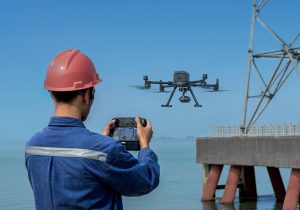In recent years, the integration of drones in various industries has brought about transformative changes in operational practices, and nowhere is this more evident than in the realm of industrial inspections. The adoption of drones for inspections has ushered in a new era of enhanced worker safety and operational efficiency. This innovative approach not only minimizes risk factors for workers but also significantly improves the accuracy and thoroughness of inspections. One of the most compelling advantages of utilizing drones in industrial inspections is the substantial improvement in worker safety. Traditionally, industrial inspections have often required workers to access hard-to-reach and hazardous areas, exposing them to potential accidents and health risks. With drones taking on the inspection tasks, human exposure to these dangers is greatly reduced. Drones can navigate confined spaces, elevated structures, and toxic environments with ease, eliminating the need for workers to put themselves in harm’s way. This not only prevents potential injuries but also lowers the occurrence of work-related accidents, leading to a safer work environment overall.

Beyond safety enhancements, the incorporation of drones in inspections also leads to remarkable gains in ats lab operational efficiency. Drones are capable of capturing high-resolution images and videos, enabling inspectors to assess equipment and infrastructure conditions in meticulous detail. They can swiftly cover vast areas, reducing the time required for inspections compared to manual methods. This expeditious data collection translates into quicker decision-making processes, enabling timely maintenance interventions and reducing downtime of critical assets. Moreover, the data collected by drones can be instantly transmitted to analysis software, where machine learning algorithms can detect anomalies, corrosion, or structural defects, further expediting the assessment process. The financial implications of adopting drones for industrial inspections are noteworthy as well. While initial investment costs may be a consideration, the long-term savings in terms of reduced labor hours, minimized equipment downtime, and prevention of costly breakdowns are substantial.
By addressing potential issues before they escalate, businesses can cut down on maintenance expenses and extend the lifespan of their assets. This proactive approach to maintenance also enhances the reliability of equipment and reduces the likelihood of unplanned outages, which can lead to substantial financial losses. In conclusion, the deployment of drones in industrial inspections represents a remarkable stride forward in the pursuit of worker safety and operational efficiency. By mitigating the risks associated with manual inspections and streamlining the data collection and analysis processes, drones are revolutionizing the way industries approach maintenance and asset management. The benefits encompass not only safer working conditions and reduced operational risks but also enhanced financial outcomes through smarter asset maintenance strategies. As technology continues to advance, it is evident that drones will remain a pivotal tool in shaping the future landscape of industrial inspections.